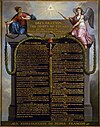
Marie-Joseph Paul Yves Roch Gilbert du Motier de La Fayette, Marquis de La Fayette, known in the United States as Lafayette, was a French nobleman and military officer who volunteered to join the Continental Army, led by General George Washington, in the American Revolutionary War. Lafayette was ultimately permitted to command Continental Army troops in the decisive Siege of Yorktown in 1781, the Revolutionary War's final major battle that secured American independence. After returning to France, Lafayette became a key figure in the French Revolution of 1789 and the July Revolution of 1830 and continues to be celebrated as a hero in both France and the United States.

William Rush was a U.S. neoclassical sculptor from Philadelphia, Pennsylvania. He is considered the first major American sculptor.
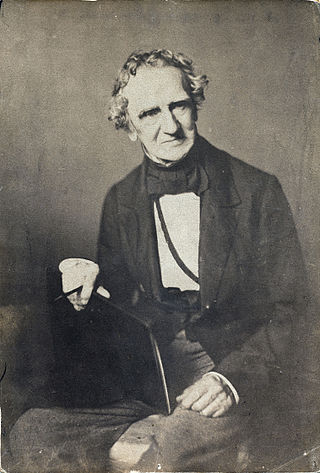
Thomas Sully was an English-American portrait painter. He was born in England, became a naturalized American citizen in 1809, and lived most of his life in Philadelphia, Pennsylvania, including in the Thomas Sully Residence. He studied painting in England under Benjamin West. He painted in the style of Thomas Lawrence and has been referred to as the "Sir Thomas Lawrence of America".

Mount Lafayette is a 5,249-foot (1,600 m) mountain at the northern end of the Franconia Range in the White Mountains of New Hampshire, United States. It lies in the town of Franconia in Grafton County, and appears on the New England Fifty Finest list of the most topographically prominent peaks in New England. The mountain's upper reaches are located in the alpine zone, an area where only dwarf vegetation exists due to the harsh climate.

Independence National Historical Park is a federally protected historic district in Philadelphia, Pennsylvania that preserves several sites associated with the American Revolution and the nation's founding history. Administered by the National Park Service, the 55-acre (22 ha) park comprises many of Philadelphia's most-visited historic sites within the Old City and Society Hill neighborhoods. The park has been nicknamed "America's most historic square mile" because of its abundance of historic landmarks.
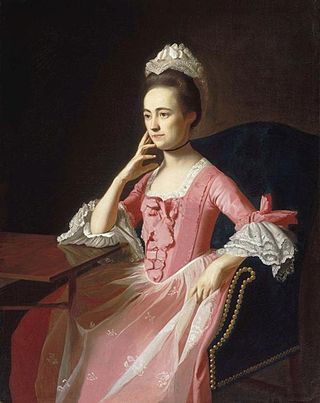
Dorothy Quincy Hancock Scott was an American hostess, daughter of Justice Edmund Quincy of Braintree and Boston, and the wife of Founding Father John Hancock. Her aunt, also named Dorothy Quincy, was the subject of Oliver Wendell Holmes' poem Dorothy Q.
Adam King was a Jacksonian member of the U.S. House of Representatives from Pennsylvania.
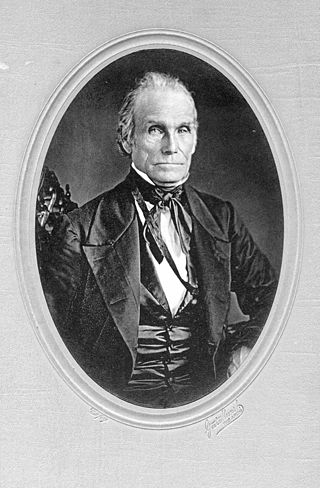
James Harper was an Irish-American politician who served as a National Republican member of the U.S. House of Representatives for Pennsylvania's 2nd congressional district from 1833 to 1837.

The Wyck house, also known as the Haines house or Hans Millan house, is a historic mansion, museum, garden, and urban farm in the Germantown neighborhood of Philadelphia, Pennsylvania. It was recognized as a National Historic Landmark in 1971 for its well-preserved condition and its documentary records, which span nine generations of a single family.

Georges Washington Louis Gilbert de La Fayette was the son of Gilbert du Motier, Marquis de Lafayette, the French officer and hero of the American Revolution, and Adrienne de La Fayette. He was named in honor of George Washington, under whom his father served in the Revolutionary War.

From July 1824 to September 1825, the French Marquis de Lafayette, the last surviving major general of the American Revolutionary War, made a tour of the 24 states in the United States. He was received by the populace with a hero's welcome at many stops, and many honors and monuments were presented to commemorate and memorialize the visit.
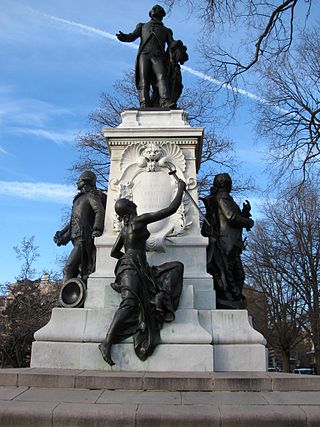
Major General Marquis Gilbert de Lafayette is a statue in the southeast corner of Lafayette Square, in Washington, D.C., near the intersection of Pennsylvania Avenue and Madison Place, across the street from the White House. The statue was erected in 1891 to honor Gilbert du Motier, Marquis de Lafayette, and his contributions in the American Revolutionary War. The square, originally part of the President's Park, was named in honor of the Marquis in 1824 during a visit he made to the U.S. The statuary was made by Alexandre Falguière and Antonin Mercié, and the architect who designed the marble pedestal was Paul Pujol. The monument comprises a bronze statue of the Marquis de Lafayette about 11 ft (3.4 m) high, standing on a French marble pedestal with four faces decorated with classical mouldings, accompanied by seven additional bronze statues, all larger than life size.
André-Nicolas Levasseur was a 19th-century French writer and diplomat known in the United States for accompanying the Marquis de La Fayette during his last trip to the Americas and in the Caribbean and Mexico for his involvement in French imperialism.

Gilbert du Motier, Marquis de Lafayette (1757–1834), a French aristocrat and Revolutionary War hero, was widely commemorated in the U.S. and elsewhere. Below is a list of the many homages and/or tributes named in his honor:

The Justice Bell is a replica of the Liberty Bell made in 1915. It was created to promote the cause for women's suffrage in the United States from 1915 to 1920. The bell is on permanent display at the Washington Memorial Chapel in Valley Forge National Park in Pennsylvania.

Lafayette in the Somewhat United States is a 2015 non-fiction book written by Sarah Vowell about the travels of the American and French revolutionary Marquis de Lafayette in early America.

The Lafayette Welcoming Parade of 1824 was a parade held in New York City on August 16, 1824, to welcome the arrival of the Marquis de Lafayette on the occasion of his visit to the United States for a sixteen-month tour. It has been described as the first triumphal parade in New York history.
Adam Marshall was an American Catholic priest and Jesuit. He briefly served as president of Washington Seminary, and later became the first Catholic chaplain in the United States Navy, albeit unofficially.

Joseph Watson was an American merchant and politician. He was the mayor of Philadelphia from 1824 to 1828. Watson was known for his efforts to free free blacks who had been kidnapped in Philadelphia and transported to southern plantations as slaves and in pursuing members of Patty Cannon's gang of kidnappers.
Hannah Archer Till worked as a paid cook and servant for George Washington. Till accompanied General Washington on his American Revolutionary War campaigns and was present at Valley Forge. She also worked for the Marquis de Lafayette for six months. She was honored as a Patriot by the Daughters of the American Revolution in 2015, in Eden Cemetery, located in Collingdale, Pennsylvania.


















